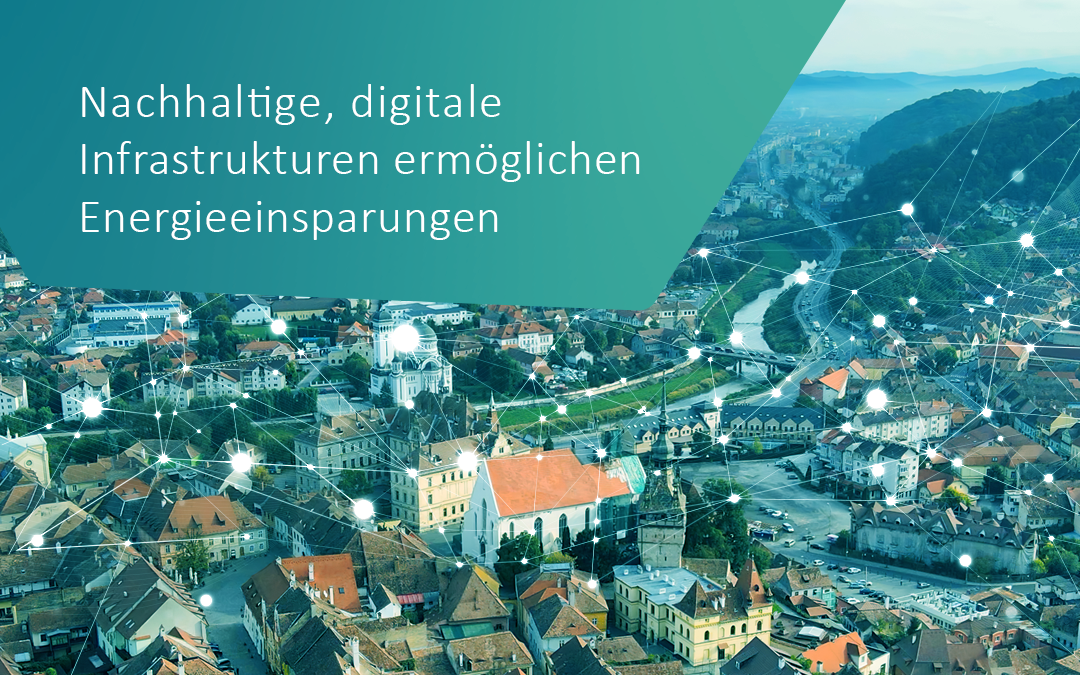It sounds like a contradiction in terms that the expansion of digital infrastructures such as fiber optic and 5G networks can have a positive effect on achieving climate targets. After all, digital components and devices require electricity and the expansion of infrastructure also ties up considerable resources.
However, intelligently designed communication networks and smart solutions also hold enormous potential, as the operation of new infrastructure in particular requires less energy. It is important to focus on the issue of sustainability, as there is no alternative to digital infrastructures: the amount of data in the mobile network is currently doubling every two years. According to statista.de, 122 billion gigabytes will have been moved in stationary broadband Internet traffic in Germany in 2022. This corresponds to an increase of 20.8% compared to the previous year. Forecasts indicate that demand will continue to grow rapidly. The fact is that the fundamental digital transformation of society is in full swing and the electronic communication networks themselves must become more energy and resource efficient in order to achieve climate targets.
Germany has set itself the target of emitting around 65% fewer greenhouse gases in 2030 than in 1990. Greenhouse gases must be reduced by 88 percent by 2040 and greenhouse gas neutrality must be achieved by 2045. Digitalization should help with this. According to a Bitkom study from May 2022, the companies surveyed are already seeing the climate effects of digitalization measures. In 77% of cases, CO2 emissions have been reduced overall through the use of technologies and applications. For example, the networking of devices and machines via the internet helps to increase energy efficiency, partly because consumption is much more directly recognizable and controllable. However, energy requirements are increasingly shifting from the end devices to the servers. It is true that the operation of servers, storage and applications in a large data center is generally more efficient than the operation of this infrastructure on site in each individual company. However, as the number, size and utilization of data centers increases, so does their energy demand. In 2021, German centers consumed almost 17 terawatt hours – more than all end consumers in the capital. And more and more server parks are being built. Four new data centers are planned in Berlin alone. Globally, the internet’s electricity requirements are in sixth place in the ranking of all countries, just ahead of Canada.
In summary, this means that digital technologies, networking and infrastructures are both a challenge and an opportunity for environmental policy.
Tim Brauckmüller, Managing Director of aconium, took part in the panel “Digital infrastructures and Germany’s sustainable future” at the “Connected Germany” trade fair and gave an insight into how sustainable digital infrastructures can be. Together with Alexander Rabe, Managing Director, eco Association of the Internet Industry and Therese Seiringer, Head of Sustainability, Vodafone, he discussed the possibilities of how digital infrastructures can become greener and more sustainable. He pointed out that there is still a lot of untapped potential here: “Digital infrastructures and sustainability need to be considered much more together. This also applies to regulation, for example, where there are many different EU directives in several sectors. Intersectoral thinking must begin here. We should agree on minimum standards and standardize common interfaces, for example.” Brauckmüller sees potential savings in the public sector: “We will see many public transport projects in the municipal sector where significant energy savings can be made thanks to the establishment of 5G networks. But here, too, we have to look at the entire value chain and bear in mind that sustainable investments can often be higher at the beginning than short-term, unsustainable expenditure.” However, according to the aconium Managing Director, even very practical approaches, such as the use of waste heat from data centers and the local disposal of expansion waste during fiber optic expansion, can make a small contribution to the environment. Digital infrastructure and data centers will certainly be more closely monitored from an energy perspective in the future and there will also be government regulations to increase their efficiency. This includes plans to achieve the prerequisite for the creation of a cadastre and thus the basis for effective sector coupling (e.g. municipal heat planning) through uniform statistical recording of data centers. The first key figures that can be used to assess the energy and resource efficiency of a data center have already been determined in the Federal Environment Agency’s KPI4DCE project. In addition, municipalities are being supported as part of the National Climate Protection Initiative to improve the efficiency of data centers.
Savings potential everywhere, from the private sector to the municipal sector
The private sector has also discovered this topic for itself. In Luleå, in northern Sweden, the use of waste heat from data centers is already a reality. A district heating and cooling network free of fossil fuels is in operation here, which works in conjunction with a fuel cell-powered data center in which waste heat is recovered. There are also initial pilot projects in Germany, for example in Frankfurt/Main. In 2023, Frankfurt energy supplier Mainova AG and data center operator Telehouse Deutschland GmbH plan to launch a heating concept in the “Westville” residential district. Around 1,300 newly built apartments and commercial units in the Gallus district with an annual requirement of 4,000 megawatt hours (MWh) will then be supplied with at least 60 percent of their heat from the waste heat from the neighboring data center. The heat generated in the server farms can then be used to heat the homes of 3,000 people. The combination of the otherwise unused waste heat from the data center and district heating to cover peak loads will save 400 tons of CO2 per year compared to conventional heat generation.
Companies are still doing this voluntarily. However, a sustainability seal or energy certificates for data centers as well as a CO2 label for online services could help to make companies more accountable when it comes to climate protection. The digital infrastructure is also important when it comes to saving energy. The data flow via the old 3G mobile network consumes around 45 times more CO2 than via fiber optic cable – another argument for the rapid expansion of fiber optic connections. A study also comes to the conclusion that 15 percent of the climate targets will be achieved more quickly with 5G – due to the more efficient use of energy. The use of the individual components in itself already consumes less energy than previous mobile technologies.
This knowledge must be continuously passed on to the people who make the decisions. Many companies and employees in the public sector would like better and more advice on how digital technologies can be used for greater sustainability. Even if the information is available, it often remains a difficult, individual consideration. Video conferencing, for example, reduces the environmental impact that would otherwise have been caused by travel. On the other hand, many employees want direct contact with customers and colleagues. However, sensible decisions require correct and up-to-date data. Large companies already have to report their climate figures as part of their sustainability reporting. The EU is planning to oblige even more companies to do so from 2024. By then, 49,000 companies across Europe will have to publish a sustainability report on non-financial information. In addition to environmental aspects, this also includes social and employee issues, respect for human rights and the fight against corruption and bribery. However, it is not only in the private sector that sustainability and environmental awareness will become more and more firmly established.
Environmental requirements will also increasingly be included as technical specifications in public tenders. Sustainable, digital solutions will be in demand in many cities and municipalities in the future. Numerous use cases are being developed as part of funding programs and pilot projects at municipal level and could then be transferred to other municipalities if they work and are economically viable. Here, too, aconium GmbH sees itself as a partner to local authorities and has a wealth of experience, including in organizing and supporting networks, platforms and other innovative approaches to knowledge transfer and exchange.

